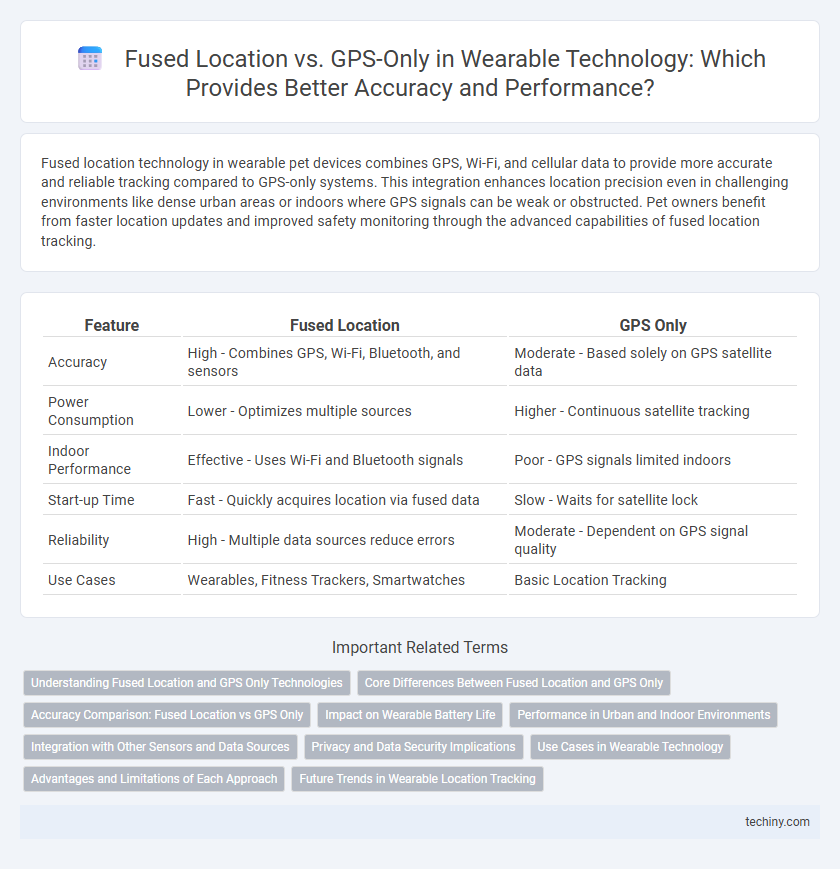Fused location technology in wearable pet devices combines GPS, Wi-Fi, and cellular data to provide more accurate and reliable tracking compared to GPS-only systems. This integration enhances location precision even in challenging environments like dense urban areas or indoors where GPS signals can be weak or obstructed. Pet owners benefit from faster location updates and improved safety monitoring through the advanced capabilities of fused location tracking.
Table of Comparison
| Feature | Fused Location | GPS Only |
|---|---|---|
| Accuracy | High - Combines GPS, Wi-Fi, Bluetooth, and sensors | Moderate - Based solely on GPS satellite data |
| Power Consumption | Lower - Optimizes multiple sources | Higher - Continuous satellite tracking |
| Indoor Performance | Effective - Uses Wi-Fi and Bluetooth signals | Poor - GPS signals limited indoors |
| Start-up Time | Fast - Quickly acquires location via fused data | Slow - Waits for satellite lock |
| Reliability | High - Multiple data sources reduce errors | Moderate - Dependent on GPS signal quality |
| Use Cases | Wearables, Fitness Trackers, Smartwatches | Basic Location Tracking |
Understanding Fused Location and GPS Only Technologies
Fused location technology integrates data from GPS, Wi-Fi, Bluetooth, and cellular networks, enhancing accuracy and reliability in wearable devices compared to GPS-only systems that rely solely on satellite signals. This multi-source approach significantly reduces signal loss in urban canyons and indoor environments, providing continuous tracking essential for fitness and health monitoring. GPS-only devices often experience delays or inaccuracies in dense areas, whereas fused location capabilities ensure seamless user experience through smarter positioning algorithms.
Core Differences Between Fused Location and GPS Only
Fused Location combines data from GPS, Wi-Fi, Bluetooth, and cellular networks to provide more accurate and faster location tracking, especially in urban or indoor environments where GPS signals may be weak or obstructed. GPS Only relies solely on satellite signals, which can result in slower positioning and reduced accuracy in areas with tall buildings, dense foliage, or indoor settings. Wearable technology leveraging Fused Location benefits from enhanced location precision, quicker response times, and improved battery efficiency compared to devices using GPS Only.
Accuracy Comparison: Fused Location vs GPS Only
Fused Location technology combines data from GPS, Wi-Fi, Bluetooth, and sensors like accelerometers to deliver higher positioning accuracy than GPS-only systems. While GPS-only devices rely solely on satellite signals, which can be obstructed in urban canyons or indoors, fused location mitigates signal loss by integrating multiple data sources. This integration results in faster location fixes and more precise tracking essential for wearable technology applications.
Impact on Wearable Battery Life
Fused location technology combines GPS, Wi-Fi, Bluetooth, and sensor data to provide accurate positioning while significantly reducing power consumption compared to GPS-only systems. This integration optimizes wearable battery life by minimizing the need for continuous GPS signal acquisition, which is energy-intensive. Wearables using fused location can operate longer on a single charge, enhancing user experience and device reliability.
Performance in Urban and Indoor Environments
Fused location technology combines GPS, Wi-Fi, Bluetooth, and sensor data to deliver superior positioning accuracy compared to GPS-only systems, especially in urban canyons and indoor environments where satellite signals are weak or obstructed. This integration reduces signal loss and multipath errors common in dense cityscapes, ensuring more reliable and precise tracking for wearable devices. Consequently, fused location enhances user experience by providing consistent and faster location updates for navigation and activity monitoring in challenging urban and indoor settings.
Integration with Other Sensors and Data Sources
Fused Location technology combines GPS with data from accelerometers, gyroscopes, and magnetometers to provide more accurate and reliable positioning in wearable devices. By integrating multiple sensor inputs, it compensates for GPS signal loss or inaccuracies, especially in indoor or urban environments. This sensor fusion enhances real-time tracking, fitness monitoring, and navigation capabilities, outperforming standalone GPS in complex scenarios.
Privacy and Data Security Implications
Fused location technology combines GPS, Wi-Fi, Bluetooth, and cellular data to enhance positioning accuracy but raises complex privacy concerns due to aggregating multiple data sources, increasing the risk of unauthorized tracking or data breaches. GPS-only tracking limits data collection to satellite signals, potentially offering a more straightforward privacy profile but often at the expense of precision and reliability in dense urban or indoor environments. Wearable device manufacturers must implement robust encryption and user-consent protocols to safeguard location data and mitigate vulnerabilities inherent in fused location systems.
Use Cases in Wearable Technology
Fused location technology combines GPS data with signals from Wi-Fi, Bluetooth, and cellular networks to provide more accurate and reliable positioning in wearable devices, especially in urban environments and indoors where GPS signals may be weak. This enhanced accuracy supports use cases such as fitness tracking, navigation, and emergency response by delivering precise real-time location information. In contrast, GPS-only wearables may struggle with signal loss or delays, limiting their effectiveness in complex environments.
Advantages and Limitations of Each Approach
Fused location combines data from GPS, Wi-Fi, Bluetooth, and sensors to enhance positioning accuracy and reduce power consumption, making it ideal for wearable technology in urban environments or indoors. GPS-only provides precise geolocation outdoors but suffers from limited accuracy indoors and higher battery drain. Fused location's advantage lies in seamless switching between sources for reliable tracking, while GPS-only maintains superior accuracy in open spaces but lacks versatility.
Future Trends in Wearable Location Tracking
Fused location technology integrates GPS, Wi-Fi, Bluetooth, and sensor data to deliver superior accuracy and reliability compared to GPS-only tracking in wearable devices. Future trends emphasize the development of AI-powered algorithms for real-time data fusion, enhanced energy efficiency to prolong battery life, and increased use of 5G connectivity to support seamless location tracking in diverse environments. These advancements position fused location systems as the foundation for next-generation wearables, enabling precise health monitoring, augmented reality, and context-aware services.
Fused Location vs GPS Only Infographic

 techiny.com
techiny.com